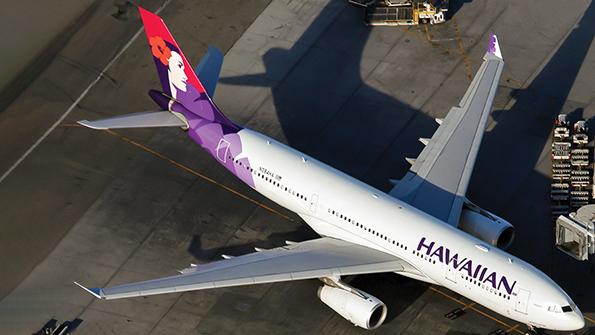
Hawaiian said last spring that it plans to equip its Airbus A330s like this one as well as A321neos and Boeing 787-9s with free IFC via Starlink.
The problem with Wi-Fi, Delta Air Lines’ CEO says, is that it does not work as an ancillary revenue stream.
“People want to figure out a way to make money on it as a product in and of itself, and you can never invest enough to have it with the reliability that you need, the quality that you need, at a price point that people are willing to pay,” CEO Ed Bastian said April 18 at the Aviation Week Network’s MRO Americas conference in Atlanta.
- Delta plans to join JetBlue in offering free Viasat service by year-end
- Hawaiian will provide connectivity with Starlink
In January, the airline announced it would make inflight connectivity (IFC) complimentary for all members of its free loyalty program, SkyMiles. Only one U.S. airline provides IFC for free on this scale—JetBlue Airways offers “Fly-Fi” through Viasat “at every seat, on every plane.”
Delta sees the product as a differentiator in building loyalty. “The core premise of Wi-Fi is to provide it as an additional reason for flying Delta,” Bastian said. “This is not easy to do. This is not about finding a new satellite contract and flipping the switch. . . . The challenges as an innovator are difficult and expensive.”
The carrier’s investments are part of a larger trend—as IFC technologies improve, U.S. airlines are upgrading service. Some are doing so with trials of free access.
On an existing fleet equipped with its legacy provider Anuvu, Southwest Airlines is installing latest-generation routers and modems. So far it has equipped more than 350 aircraft, with installations on the full fleet expected to be completed by the third quarter. The carrier’s new aircraft are equipped with Viasat; it received the first of these in early March. Southwest charges $8 per device for internet access from takeoff to landing.
Wi-Fi on United Airlines and American Airlines comes through several providers and is offered onboard starting at $8-10. T-Mobile subscribers on eligible plans can connect for free on domestic and international United flights as well as on American’s Intelsat-equipped aircraft—expanding this quarter to include the airline’s Viasat-equipped aircraft under a 12-month agreement.
American also grants Boingo customers free Wi-Fi access on its Viasat-equipped aircraft and for iPass customers on those with Panasonic equipment. It began a trial in April 2022 for 20 min. of free Wi-Fi onboard 25% of its domestic flights operated on narrowbodies with Viasat. “[The trial] is helping American understand which experiences are most meaningful for customers,” a spokesperson tells Aviation Week.
Hawaiian Airlines will join Delta and JetBlue soon in offering free connectivity. It will provide complimentary access via SpaceX’s Starlink on all its transpacific aircraft. The carrier plans to equip its A321neos first, followed by its A330s and an incoming fleet of Boeing 787-9s. Hawaiian expects to begin offering the service this year on select aircraft.
“We waited until technology caught up with our high standards for guest experience, but it will be worth the wait,” Hawaiian Airlines President and CEO Peter Ingram said in the airline’s April 2022 announcement.
Bastian described Delta’s offering as part of the core onboard customer experience. The airline has seen results since it began rolling out the service for free in December.
“If you’re thinking about the customer for the long term, you’re thinking about your next generations of customers, it’s key,” he told MRO Americas attendees. “The only thing to be able to get onto our Wi-Fi portal that we ask our customers is to be a member of our SkyMiles program. And interestingly, about half of the [people signing up]—the raw numbers in terms of unique customers—are not [already] members of our program. Just since this soft launch in the first part of the winter, we’ve gained 500,000 new younger customers . . . [with an] average age of 32, which is almost 10 years younger than the average age of our current SkyMiles profiles.”
Delta expects free Wi-Fi to be available on all its domestic flights by year-end and on all international and regional flights by the end of 2024. Bastian noted that the company has invested more than $1 billion in the last three years on its system. “We’re thinking long-term, we’re thinking about what customers need for the future,” he said. “And being connected in the sky is just as important as the destination you’re going to for some people.”
While other U.S. airlines have not announced plans for free IFC, industry entrepreneur David Neeleman may be leaning in that direction. The Breeze Airways CEO and management team are not yet in agreement on whether Wi-Fi should be free on their Airbus A220 fleet being outfitted with Viasat, but Neeleman told reporters at ISTAT Americas in March: “There is a reason why Delta did away with the $5 charge.”
—With Jens Flottau in San Diego
Editor's note: This article was updated to include more information about Hawaiian's IFC plans.
